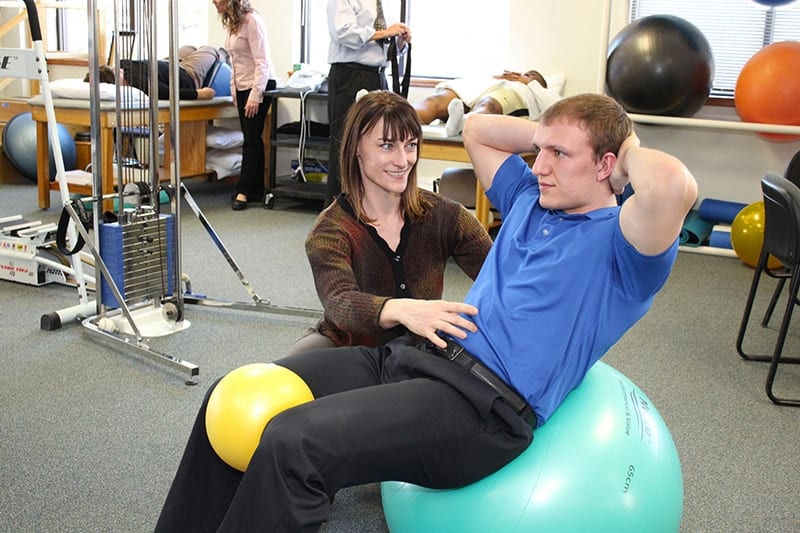 You’re sitting in your living room and glance at the clock: just fifteen minutes until your physical therapy appointment is scheduled to start. You still need to lace up your shoes, grab your wallet, jump in the car and drive 10 miles across town. The walk from the parking alone will take five minutes! How will you ever make it on time?
You’re sitting in your living room and glance at the clock: just fifteen minutes until your physical therapy appointment is scheduled to start. You still need to lace up your shoes, grab your wallet, jump in the car and drive 10 miles across town. The walk from the parking alone will take five minutes! How will you ever make it on time?
With rapid advances in telehealth technologies, this scenario could soon become a thing of the past—at least for some of your physical therapy visits. Instead of racing out the door, it’s possible that soon you’ll be able to flip on a telerehabilitation system from your living room. While the arrival of televisits in the rehab world doesn’t mean that your care will be delivered entirely through a screen, it does mean that you’re likely to have fewer in-person appointments with your physical therapist.
While we still don’t know exactly what telemedicine will look like for physical therapy—or when it will become a mainstream offering—we do know that the benefits for both patients and clinicians are numerous. The #1 benefit that draws patients to telehealth services of any kind is convenience. Here are a few ways that televisits could make physical therapy appointments more convenient for patients:
- Saves precious time. Time spent traveling from the home, office or school to the physical therapy clinic (and back again) can really add up. While the time saved by visiting with a physical therapist virtually varies from patient to patient, who doesn’t need extra time (even five minutes!) to fold laundry, complete a homework assignment or answer the boss’ email?
- Puts more greenbacks in your wallet. Traveling to the outpatient clinic costs money—whether you travel by foot (sneakers and other appropriate attire), car (gas and parking), or by bus, train or rideshare service (fare). Other factors to consider are childcare costs and the wages lost by potentially missing work. Televisits will likely save you money.
- Keeps stress levels in check. The details involved in getting to a physical therapy appointment can be stressful, especially for those with competing priorities like childcare responsibilities or travel barriers like unreliable transportation.
In today’s world of e-retailers and smartphones, convenience is important to consumers. Today’s consumers can use an app to have groceries delivered to the home in less than an hour or ask a voice assistant to play their favorite songs without getting up from the couch. Naturally, the demand for a similar experience is spilling over into healthcare.
In fact, nearly 77% of consumers are willing to consider meeting with a healthcare provider virtually, according to a Virtual Visits Consumer Choice Survey from Advisory Board.
Beyond the obvious advantages of cost savings and convenience, telehealth technology would allow PTs to observe, guide and educate patients to ensure that they complete their home exercise programs and other rehab-related goals on-schedule and safely. The results of using it as a complementary service in certain patient populations have thus far been encouraging.
The Cleveland Clinic recently conducted a study using home-based virtual physical therapy with 157 post-op knee surgery patients. In addition to other measures, the study authors assessed the patients’ ability to adhere to the program and the results were encouraging: Nearly 80% of study participants adhered to all prescribed home therapy. That statistic is in sharp contrast to the self-reported adherence rates of 35 to 70% in traditional PT settings.
Patients enrolled in the Cleveland Clinic study used a telerehabilitation system that was equipped with an instructional avatar, three-dimensional motion measurement and analysis software, and real-time televisits capability. Adherence was measured by how many times the patients complied with the prescribed exercise programs—as well as time spent performing the exercises. The televisits were conducted in conjunction with a few in-person visits in the outpatient clinic.
As telehealth begins to infiltrate the physical therapy profession, there’s evidence that the intervention makes patients feel engaged, supported and motivated. Virtual physical therapy could become a more widespread avenue for providing on-demand, high-quality care. Would you participate?
——————-
Until televisits become available down the road, you’re welcome to come see the friendly professionals here at North Boulder Physical Therapy. With two offices in Boulder, as well as locations in Westminster and Golden, we just might be in your neighborhood. Contact us today to schedule your appointment.



